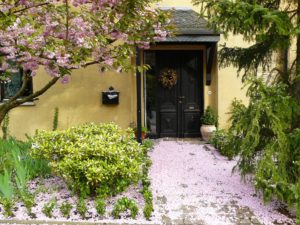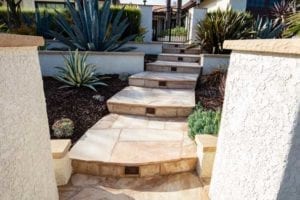Decomposed granite (DG) is a versatile and popular landscaping material formed from the weathering and erosion of solid granite. It offers several advantages and disadvantages, making it essential to weigh its pros and cons before choosing it for your outdoor projects.
In this comprehensive article, we will explore both the benefits and drawbacks of decomposed granite to help you make an informed decision for your landscaping needs.

Advantages of Decomposed Granite
1. Low Maintenance
One of the most significant advantages of using decomposed granite is its low maintenance. Once installed, it doesn’t require watering, mowing, or fertilizing, making it an excellent choice for busy homeowners or those seeking an easy-to-care-for landscape.
2. Cost-Effective
Decomposed granite is a budget-friendly option for landscaping and construction projects. It is more affordable than materials like concrete, natural stone, or pavers, making it accessible to a wide range of budgets.
3. Sustainable
DG is an environmentally friendly material, consisting of natural particles that have weathered over time. It doesn’t require the use of harmful chemicals or additives, aligning with eco-conscious landscaping practices.
4. Versatility
Decomposed granite is a versatile material that can be used in various ways. It serves as a reliable base material for pathways, patios, and driveways, while also lending itself well to decorative use in gardens and outdoor spaces.
5. Durability
DG stands up to heavy use and foot traffic, making it a long-lasting investment for landscaping projects. Its resistance to erosion ensures it retains its functionality and aesthetics over time.
6. Excellent Drainage
The permeable nature of DG allows for efficient water drainage, which is advantageous in areas prone to heavy rainfall or flooding. It helps prevent water pooling and runoff, reducing the risk of erosion.
7. Natural Appearance
The rustic and natural appearance of decomposed granite enhances the aesthetic appeal of gardens, pathways, and outdoor spaces. Its earthy tones blend seamlessly with various landscapes.
8. Customization
Decomposed granite comes in different colors and particle sizes, allowing for customization to suit your design preferences. Whether you want a fine, sandy texture or a coarser gravel-like appearance, DG offers flexibility.
Disadvantages of Decomposed Granite
1. Dusty and Dirty
One of the biggest disadvantages of using decomposed granite is that it can be quite dusty and dirty. In areas with high foot traffic, the dust and dirt can easily be kicked up and spread around, making it difficult to keep the surrounding area clean.
2.Limited Color Options
DG’s natural origin restricts its color options to earth tones. If you require a specific color or hue to match your existing landscaping or home exterior, decomposed granite may not be the best choice.
3. Prone to Erosion
Erosion can be a concern with decomposed granite, especially in regions experiencing heavy rainfall or strong winds. The loose material can wash away or be blown away over time, requiring periodic maintenance.
4. Difficult to Walk On
Due to its composition of small particles, decomposed granite can be challenging to walk on, particularly for individuals with mobility issues or those using mobility aids like wheelchairs or walkers. The material’s tendency to shift and move underfoot can create an unstable and potentially hazardous surface.
5. Requires Regular Maintenance
While generally low-maintenance, decomposed granite does need some upkeep to maintain its appearance and functionality. Regular raking and leveling, along with occasional additions of new material to replenish what’s lost due to erosion or other factors, are necessary to keep it in optimal condition.
6. Weed Growth
One common issue with decomposed granite is weed growth. Over time, seeds can settle in the DG, leading to weed proliferation. Regular weeding is necessary to maintain its appearance and prevent unwanted vegetation.
7. Color Fading
The color of DG may fade over time, especially in areas with heavy sun exposure. This can lead to a less vibrant appearance and may require periodic color enhancement if a consistent look is desired.
8. Not Suitable for Play Areas
Due to the potential for dust and the rough texture of DG, it’s not an ideal surface for play areas or places where children may be running or playing. Safety concerns should be taken into account when choosing landscaping materials for such areas.

In conclusion, decomposed granite offers numerous advantages, including affordability, low maintenance, and a natural appearance, making it a popular choice for various landscaping projects. However, it also presents challenges such as dustiness, limited color options, and erosion vulnerability. Careful consideration of these factors is essential when deciding whether to use decomposed granite in your landscaping project, along with proper planning and maintenance to maximize its benefits.
Check out Home Landscaping Tips: How to Place Stepping Stones for more inspirational ideas.


